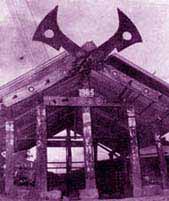|
|

|
|

|
|||
|
|||
| Morung The central piece in village was the 'Morung'. It was a kind of bachelor's dormitory for the village youth and fulfilled a variety of functions.  relics,
as a guardhouse where the village braves kept their Daos, spears and shields
and it was also a meeting place where important decisions relating to
war and peace were taken. Here the younger generation were reared to manhood,
taught folk tales and songs and it also acted as sanctuary for a culprit
who takes refuge in it, as long as he remained under its roof. The morung
was the pride of the village and was always decorated with trophies of
war and finest wood carvings the villagers were capable of. relics,
as a guardhouse where the village braves kept their Daos, spears and shields
and it was also a meeting place where important decisions relating to
war and peace were taken. Here the younger generation were reared to manhood,
taught folk tales and songs and it also acted as sanctuary for a culprit
who takes refuge in it, as long as he remained under its roof. The morung
was the pride of the village and was always decorated with trophies of
war and finest wood carvings the villagers were capable of.
But the morung is not common for all the Naga tribes. Angamis villages does not have a morung but the Ao, Lotha, Koyak and the Phom areas, every village had a morung. A striking feature of the Ao, Chang, Koyak, Yimchurger and Sangtam villages are the xylophones or the log drums. It was made out of the hollowed trunk of a tree with the carving usually of a mithun head at one end. The drum when beaten with dumb-bells by men lined up on either side, could be heard for miles. It was primarily a war-drum and was generally beaten to give an alarm or celebrate a victory, but it was also used for festivals and ceremonies. The notes for every occasion would be different. In Chan, Yimchunger and Sangtam areas it formed part of the morung and the Aos looked upon the drum as almost the village deity. Social evils like infanticide, slavery and prostitution existed in the Naga society. The Angamis resorted to infanticide in the case of children of unmarried girls. It was believed that such children would bring misfortune to the village. The girls were send to the jungle for delivery and there the baby was strangled.
Slavery was universal throughout the Ao tribe. These slaves were generally well treated and considered members of the family. The barter value of a male slave was one cow and 3 conch shells and of a female slave three cows and four or 5 conch shells. Female slaves were not allowed to marry and if they bore a child the offspring was killed. Occasionally the slaves were used for setting scores in head hunting. If it was found that one village had taken more heads than the other, and it was desired to make peace between the two, the accounts would be squared up by the village having taken more heads giving to the other village, the deficit number of slaves. These slaves were carried by the other village in triumph and decapitated. Prostitutes existed in the Chakhesang area, especially in Kezabama (Chizami). They were drawn mostly from young widows or unmarried girls. |
|||